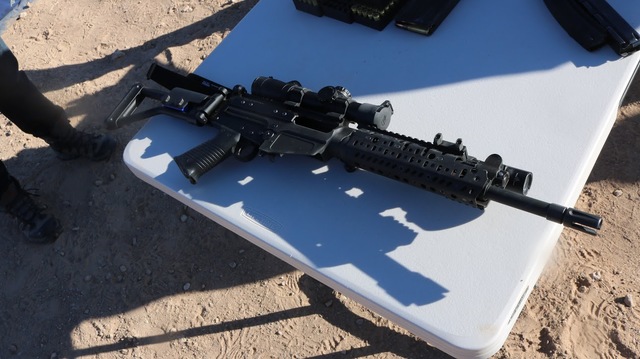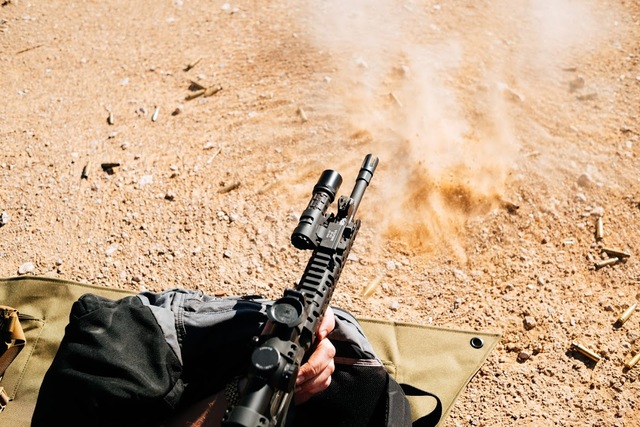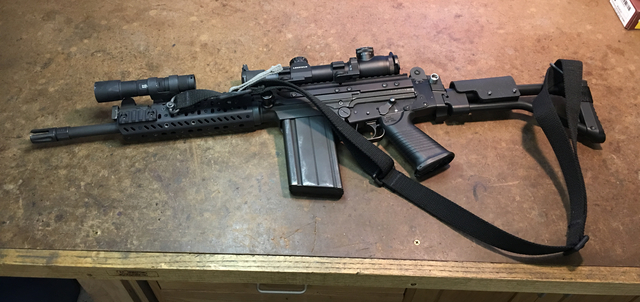Add Vise
Assembly and Test
Project Beano
A Tale of Two Testfires
More articles
Did the Gas Bushing Work?
Yes. Yes, it did.
Did the Gas Bushing Work? (extended edition)
When I took the SBR FAL to the range for the first time after installing the gas bushing, I preemptively positioned by the bench all the tools required to redrill the bushing: dremel, drillbits, a dowel to put down the bore and prevent the bit from hitting the opposite side of the barrel after going through the bushing. I plugged the extension cord in and taped it down so that other range denizens would not trip over it. (Note to readers who are my wife: This is yet another situation where a cordless drill would come in handy.) Finally, with the gas regulator tightened all the way down, I took a test shot.
It cycled just fine. In fact, it continued to cycle just fine as I opened up the regulator. It finally started short-stroking somewhere around 4.5. Adjusted down the recommended two clicks to 3.5, it cycled reliably and threw the brass about eight feet.
Filled with equal parts elation and chagrin, I packed up all the unneeded drilling equipment. Now that the overgassing issue had been solved, it was time for some accuracy testing.
Did the Rifle Shoot Accurately?
No. No, it did not.
Did the Rifle Shoot Accurately? (extended edition)
Several trips to the range with meticulously hand-loaded ammo left me disappointed. Shooting off a rest using a 5X scope, the SBR into which I'd poured so much effort shot horrid groups at 100 yards: on the order of 6 MOA, and sometimes worse.
It wasn't the ammo. I load to near match quality using an RCBS Chargemaster, match bullets, and a precision seating die. Although the ammo was tuned to a 21-inch barrel, pressure node calculations showed that it should be just as accurate out of a 13-inch tube. These were the same cartridges that produced unbelievable accuracy with a 21-inch FAL. (Better than 50% hit rate on a man-sized target at 960 yards. See? Told you that you wouldn't believe me.)
These loads were still unbelievable with the SBR FAL, just unbelievably bad. Saddened and irritated, I began researching what it would take to turn my own barrel or convert a surplus barrel to short gas. These plans had to be put on hold, though, for a shooting trip to Vegas.
Did the Rifle Shoot Accurately? (Vegas edition)
Every year or so, I go to Las Vegas to shoot at interesting distances out in the desert. This was where I took that other FAL out to nearly 1,000 yards. Although I harbored no such hopes for an SBR that patterned like a shotgun at 100 yards, it got dragged along as well.

Fine, you can come. Just try not to embarass me.
Why take an inaccurate rifle long-range shooting? Four reasons:
- It looked cool and people might have fun shooting it; since the barrel had no accuracy to preserve, there was no reason not to enjoy magdumping like some drooling dirt-shooter.
- I'd already gotten a 5320 form approved for the rifle.
- It folded up so compactly that it could be brought along without too much additional trouble.
- One last trip to the range had shown that if I tightened up behind the rifle properly and quit minding the shoulder-pounding it dished out, the rifle turned in groups that were borderline acceptable: 2.5-3 MOA. It would be interesting to see how far out the rifle could actually reach with accuracy like that.
Out in the desert, the mystery deepened. The rifle that shot horribly at 100 yards was suddenly able to nail a 2/3 IPSC silhouette at 400 yards with 100% accuracy from the prone supported position you see above. Succumbing to peer pressure, I switched to another 2/3 silhouette at 700 yards; a majority of the shots were hits. (It was impossible to keep an actual count because I was too busy laughing incredulously.) 2/3 IPSC targets at 700 yards is the accuracy equivalent of a 1,050 yard hit on full-sized steel. It doesn't mean the rifle is accurate out to 1,000 yards, though; those last 300 yards of wind and mirage make more of a difference than preceding 700. Also, the bullets out of such a short barrel go transonic before 900 yards.


Muzzle blast? What muzzle blast?
Mostly hitting a 1.5 MOA target at 700 yards is quite acceptable, though. Compared to expectations, it was unbelievable. What changed between my home range and an incredibly noisy patch of Nevada desert?
I can only offer some theories.
Some Theories
Theory One: Epicyclic Yaw. That's a fancy term for the bullet settling down at distance. It doesn't mean that absolute group sizes shrink, but it can reduce angular dispersion beyond a certain range. Going from 6 MOA to less than 2 seems a bit of a stretch to assign to bullet perterbation, but those last few groups before Vegas were more on the order of 3 MOA. However, the shrinking groups prior to the trip point to another possibility...
Theory Two: I Quit Being a Weenie. The groups coincidentally tightened up when I really got behind the rifle and resigned my shoulder to painful bruising. Shooting from prone in the desert permitted an even more stable stance. It could be that the real part causing the problem was, as they say, the nut behind the butt. Wouldn't be the first time I was the source of my problems. However, there was a component of the rifle that showed some changes after it got accurate...
Theory Three: The Handguards. After shooting quite a bit, the VLTOR handguards, ordinarily solid as a rock, exhibited a nearly imperceptible bit of wiggle. That meant some force had acted to loosen them up. Maybe they had been taking the stress of barrel flex in a way that messed with harmonics enough to impair accuracy. FALs are sensitive to barrel stress, after all; maybe that applies even when barrels are stumpy.
Theory Four: Better Desert Ballistics. Finally, maybe shooting is like real estate: all about location, location, location. Dry desert air makes for better bullet travel than the sodden soup where I typically shoot. It's not enough to make a difference by itself, but could have helped when combined with some or all of the above.
The End?
The saga of building an SBR FAL technically ends here, with a happy conclusion. I'd built a vice, tweaked a barrel's gas port, and travelled thousands of miles in pursuit of accuracy. I finally had a short-barreled FAL that shot reliably and accurately.

Worth it.
I had a lot of fun building the rifle. Even the challenging and frustrating parts produced interesting experiences and surprising conclusions. Hopefully you got something out of the story. Thanks for reading.
But Wait, There's More!
The SBR FAL project spawned a couple side projects.
While not a crucial part of building the rifle, these may be of interest
to those who have read this far. I haven't finished their writeups
yet, but they'll be linked here once complete:
- Designing a cheek riser for the para stock
- Improving para FAL sling options
email: hidi.projects@gmail.com